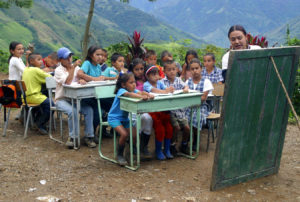Blog
Building Human Capital in Latin America
Written by Grace Avila Casanova
February 23, 2018
The dynamics of education in Latin America
The dynamics of education in Latin America represent a critical link in the intergenerational transfer of poverty. It is no coincidence that two of the nine pillars crucial to national competitiveness and productivity in the World Economic Forum’s Global Competitiveness Index deal directly with primary and higher education. A third pillar, ‘innovation’, is powerfully linked to strong research institutions and an effective university-private sector collaboration that fosters the creation of new knowledge and efficient production. But Latin America falls behind in all of these areas. The region’s ability to compete successfully in global markets depends significantly on the quality of its labour force, which in turn depends on the quality of its schools. In short, good education improves workers’ skills, promotes growth, reduces poverty and provides a strong foundation for building the institutions, transparency, and good governance that enable production to take place.
Despite rapid economic growth and subsequent optimistic forecasts in social development, educational inequalities continue to exacerbate the region’s income issues, under-utilising large portions of the labour force and contributing to social tension. Latin America is still notorious for the growing income inequalities between its rich and poor citizens. Education adds to these inequalities through its effects on earnings and is affected by them as poverty limits people’s access to learning. Thus while a small elite benefit from substantial wage for completing secondary and tertiary education, the vast majority of Latin America’s workforce fails to live up to its potential. This, in turn, has a negative impact on growth and social stability.
With modest success, Latin American countries have been working hard to improve schools. Most governments have recognised the importance of making quality education for all a driving force in economic development and social equity, and are investing more to make that happen. Throughout the region, countries have also taken important steps to establish national standards, create and consolidate national testing systems, and place more authority and responsibility in the hands of local governments and schools (critical components in making schools better). However, despite these significant achievements, student learning remains low and inadequate for the needs of modern societies.
Teaching is in crisis
Perhaps no other single area presents as great a challenge for improving education in Latin America as strengthening the teaching profession. On the one hand, teachers face enormous challenges, ranging from poor training, lack of classroom resources and istrative support to low social prestige. On the other, education management systems lack incentives to attract and retain high quality teachers and mechanisms to remove those who continue to perform poorly after a reasonable effort has been made to help them improve. Teacher training is often disconnected from classroom needs and other elements of the education system including standards, tests, and curriculum. The bigger challenge, however, is that systems for managing teachers do not promote professionalism.
Education for competitiveness
Reforming education in ways that enhance competitiveness will take time. Countries must commit themselves to fundamental changes in what schools produce and how they are managed. These pivotal reforms, necessary to prepare students for today’s knowledge economy fall into two broad categories:
1. Prioritising learning as the key measure of education success:
In shaping education, countries need to shift away from their traditional focus on inputs such as enrolments, spending, buildings, and teachers towards the most important education output: what children learn. The idea here is not to ignore inputs, but rather to recognise that outputs (in the form of learning) are what justify the inputs. It is therefore necessary that governments reorganise education systems to ensure the right outputs are produced. This implies establishing clear learning standards as well as systematically measuring how much students learn.
2. Making schools accountable to citizens:
This is both a technical and political challenge. At least five basic elements need to be in place: standards, information, consequences, authority, and capacity. These two broad measures, however, constitute a powerful institutional dynamic that holds education actors responsible for their actions as public servants. Doing that well will help tip the balance in favour of producing consistently good education.
There is documented association between poverty and educational attainment in Latin America. Turning around the vicious cycle of poverty that continues to reproduce itself in the education system requires that decision makers understand and modify the conditions that create opportunities to learn for all sectors of society.

